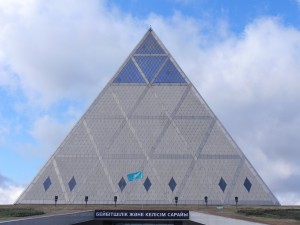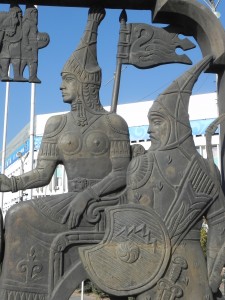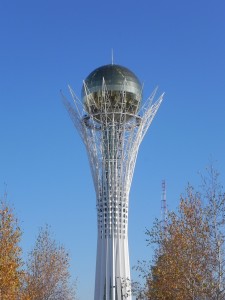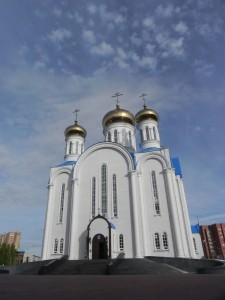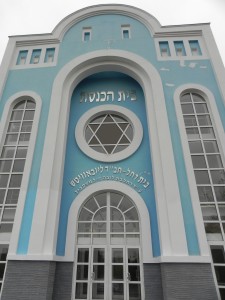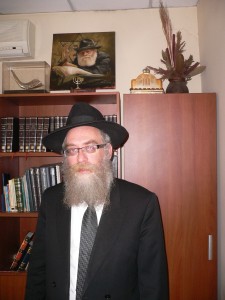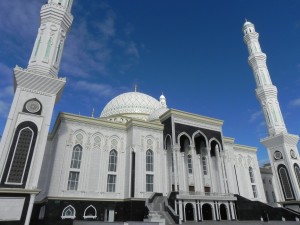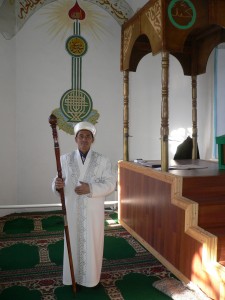“Human beings have only three virtues: the burning heart, the bright mind – and creative will.”
Abai Kunanbayev. Kazakh poet (1845-1904), Book of Words (47).
| No prosperity in a world of social unrest. Avoiding conflict needs advocating for religious tolerance. Kazakhstan invites to constructive dialogue and is a bridge-builder between East and West. |
Travelling across Kazakhstan brings Europe’s Enlightenment epoch back to mind. Lutheran Gotthold Ephraim Lessing’s (1729-1781) friendship with his Jewish contemporary Moses Mendelssohn (1729-1786) inspired him to his play, “Nathan, the Wise” (1779). The popular work was a plea for religious tolerance, bridging gaps between Judaism, Christianity and Islam.
“The centerpiece of the work is the Ring Parable, questioning true religion. A ring with the magical ability to render its owner pleasing in the eyes of God and mankind had been passed from father to the son he loved most.
When it came to a father of three sons whom he loved equally, he promised it to each of them. Looking for a way to keep his promise, he had two replicas made, which were indistinguishable from the original.
The brothers quarreled over who owned the real ring. A wise judge admonished them that it was impossible to tell – that it even could not be discounted that all three rings were replicas, the original one having been lost at some point in the past; that to find out whether one of them had the real ring it was up to them to live in such a way that their ring’s powers could prove true, to live a life that is pleasing in the eyes of God and mankind rather than expecting the ring’s miraculous powers to do so.
Kazakh spiritual culture
Many religions are present in multi-ethnic Kazakhstan. Uniting more than 120 ethnicities is a challenging undertaking for the young state, which gained independence in 1991, with the break-up of the USSR. There is smooth cooperation between Kazakh and Russian people. You would not necessarily expect a positive coexistence given the fact that previous agricultural programs led to many Kazakh deaths, and attempts to deprive Kazakhs of their culture were part of oppressive Soviet rule.

“May Kazakhstan – the land of peace and accord be blessed”. Astana, Baiterek. Oct. 2011. Photo: Ursula Gelis
A convincing symbol of religious dialogue is the Baiterek Tower, the ‘Tree of life’, in the heart of Astana. In the ‘golden egg’, Kazakhstan is depicted as the epicenter of peace, inviting people of different faiths to work for coexistence.
According to an old Kazakh legend, on the banks of the World River grew the tree of life, Baiterek. Each year the sacred bird Samruk laid a golden egg in the crown of the tree, only for it to be consumed by a dragon. This annual routine of egg laying and destruction symbolized the switch between good and evil.
The struggle between good and evil goes to the core of religions and it is easy to see that the human family is one. Finding new ways to reconcile people is a task for everyone.
The movement of spiritual concord in Kazakhstan addresses urgent questions at frequent inter-religious conferences in Astana.

Congress of Leaders of World and Traditional Religions. Astana, 2009. – Photo at the Palace Wall. Photo: Ursula Gelis
“World peace is more than a peaceful world. This concept involves structural changes in the systems of civilizations, to achieve safe coexistence. Violence, destruction, poverty – all these are the products of the old world. Along with military conflicts, global-scale environmental challenges, terrorism, the global economic crisis, the world is facing religious-based disputes. Only a world free of violence and fear is the real world,” a World Forum of Spiritual Culture in 2013 addressed the international community.
If we are talking about necessary structural changes in civilizations we have to address the fact that women are often systematically excluded from decision-making processes, both in peace and war times. How can a global society create sustainable concepts without bringing the knowledge and needs of the female population into international fora?
Religious revival
In 2010, the Cathedral of the ‘Assumption of the Virgin Mary’ (‘Uspensky’) was consecrated in Astana. For decades no Cathedral had been built in Central Asia.
Christians in Kazakhstan have left the dark years of suppression behind, when their churches were destroyed or devaluated as storage halls, priests were deported and some died as martyrs.
In May 2013, President Nursultan Nazarbayev attended an Orthodox Easter liturgy at ‘Uspensky’, saying that “today the whole world celebrates Christianity’s most important and joyful holiday – Easter. Easter means revival, renewal and also symbolizes our country, as Kazakhstan is becoming a new state where various ethnicities and religions co-exist peacefully.”
“We are all just people”
I visited the new synagogue in Astana, named after Rachel, the ‘brave mother’ of the Israelites.
Businessman Alexander Mashkevich named the synagogue, opened in 2004, in honour of his mother. The Jewish temple serves about 150 families originally from Belorussia, the Ukraine and Lithuania.
Judaism has many ramifications. In Kazakhstan, we encounter a branch called ‘Chabad- Hassidism’, maintaining a high standard in observing religious and moral commandments.
During the dark days of communism, religious leaders were persecuted and executed, Jewish institutions demolished. After the demise of the Soviet Union, messengers of Chabad-Judaism revived Jewish life in Kazakhstan.
At the Jewish community center in Almaty I introduced myself as a German visitor, and the Rabbi wants to know why millions of Jews had to die under German rule. We discuss racism and anti-Semitism, and he is emphasizing that in this region of the world, in today’s Kazakhstan, Jewish persecution never happened. He stresses Nursultan Nazarbayev’s wise and necessary decision to advocate for religious dialogue.
At a celebration which marked the 15th anniversary of Kazakhstan’s independence, the Kazakh President wished the Rabbi “Shabbat Shalom”. And he answered: “The fact that I can observe Shabbat safely in Kazakhstan can definitely be defined as a spiritual victory.”
“There are many attempts of coexistence globally, yet only in Kazakhstan the government is undertaking such an initiative”, he adds.
Finally, after a breathtaking tour de force about ethics and Jewish life, I get the chance to ask him about his name. “I am the chief Rabbi of Kazakhstan, but we are all just people.”
As-Sirat al-Mustaqim: The Straight Path
The French philosopher Voltaire (1694-1778) declared that he would not tolerate intolerance. “Are you Muslim?” This question was posed to me before I could enter a mosque in Northern Africa. Now I am sitting in the Hazrat Sultan Mosque in Astana – and it is a different story. The largest mosque in Central Asia was inaugurated in 2012.
Without any interrogation, I reached the shelves to put my shoes on, and with calm curiosity I entered the bathing section. Over impressive floors, I ascended to the main hall and simply sat down on the comfortable ground in the women’s section.
With Al-Ghazali in Semey
“When man controls his predatory quality, he acquires such virtues as courage, generosity, and dignity” (Al-Ghazali’s Ihya’ Ulum al-Din)
I am on my way to one of the mosques in Semey. Along quiet roads I am travelling back in time. Old wooden houses have preserved the atmosphere when Dostoyevsky (1821-1881) lived in Semipalatinsk. When the exiled revolutionary arrived in 1854 he was still searching for God.
Old trees are slowly shaking in soft autumn light. Not far away a friendly green minaret seems to invite me. An old wooden door gives way into the Latif Sadyk Uly Musin mosque. After finding the slippers, I enter the next room, welcomed by the Imam. I am hesitant because I am standing right in front of the men’s section. No problem for Imam Idin who takes me into the main hall and proudly shows me around. I want to demonstrate my appreciation for his kindness by writing my name in Arabic on the blackboard. He does the same. Dignity and mutual respect – does it need more?
The author is a political scientist focusing on the humanitarian consequences of nuclear testing. In May 2014 she visited Kazakhstan for the fifth time, attending the 7th Astana Economic Forum.



